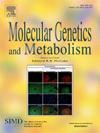Rapidly progressive, infantile lysosomal acid lipase deficiency: Prevalence in the Mizrahi Jewish population
IF 3.5
2区 生物学
Q2 ENDOCRINOLOGY & METABOLISM
引用次数: 0
Abstract
Purpose
This study was designed to more accurately estimate the prevalence of severe, infantile onset, rapidly progressive lysosomal acid lipase deficiency (LALD), an autosomal recessive disorder caused by the homoallelic LIPA gene variant, c.260G>T; p.G87V in patients of Mizrahi Jewish ancestry. The previous estimates of LALD prevalence in Middle Eastern and Mizrahi Jewish populations, ranging from 1 in 12,100 to 1 in 4200, were based on historic, observational case reports and a population genetic screening of 165 Middle Eastern individuals and 162 Mizrahi Jews living in Southern California.
Methods
Carrier screening of 549 Mizrahi Jewish individuals for the c.260G>T; p.G87V LIPA variant and the common, c.894G>A; p.E8SJM-1 LIPA variant, was carried out to determine their allele frequencies and expected prevalence of LALD in a larger Mizrahi population.
Results
This larger population screening study revealed a LIPA p.G87V Mizrahi founder variant allele frequency of 1 in 52.2, conferring a carrier frequency of 1 in 26.1. Therefore, the occurrence of infantile LALD was estimated to be one in 2724.8 Mizrahi Jewish conceptions in Southern California.
Conclusion
The present, larger study found the prevalence of rapidly progressive, infantile LALD disease was ∼35 % greater than the previous prevalence estimate in the major U.S. Mizrahi Jewish population.
快速进展的婴儿溶酶体酸性脂肪酶缺乏症:在米兹拉希犹太人群中的患病率
目的本研究旨在更准确地估计严重的、婴儿期发病的、快速进行性溶酶体酸性脂肪酶缺乏症(LALD)的患病率。LALD是一种常染色体隐性遗传病,由同等位基因LIPA基因变异c.260G>;T引起。p.G87V在米兹拉希犹太血统的患者中。先前对中东和米兹拉希犹太人LALD患病率的估计,范围从1 / 12100到1 / 4200,是基于历史观察病例报告和165名中东人和162名居住在南加州的米兹拉希犹太人的群体遗传筛查。方法对549名米兹拉希犹太人进行c - 260g >;T携带者筛查;p.G87V LIPA变型和普通型,c.894G>;A;p.E8SJM-1 LIPA变异,以确定他们的等位基因频率和LALD在更大的米兹拉希人群中的预期患病率。结果这项更大规模的人群筛查研究显示,LIPA p.G87V Mizrahi创始人变异等位基因频率为1 / 52.2,携带者频率为1 / 26.1。因此,在南加州,婴儿LALD的发生率估计为2724.8分之一的米兹拉希犹太人。目前,这项更大规模的研究发现,在美国米兹拉希犹太人中,快速进展的婴儿LALD疾病的患病率比先前估计的患病率高35%。
本文章由计算机程序翻译,如有差异,请以英文原文为准。
求助全文
约1分钟内获得全文
求助全文
来源期刊

Molecular genetics and metabolism
生物-生化与分子生物学
CiteScore
5.90
自引率
7.90%
发文量
621
审稿时长
34 days
期刊介绍:
Molecular Genetics and Metabolism contributes to the understanding of the metabolic and molecular basis of disease. This peer reviewed journal publishes articles describing investigations that use the tools of biochemical genetics and molecular genetics for studies of normal and disease states in humans and animal models.
 求助内容:
求助内容: 应助结果提醒方式:
应助结果提醒方式:


